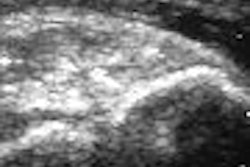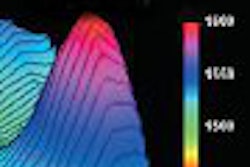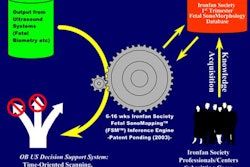Increased interest in screening examinations and early identification of disease offer an opportunity for expanded use of ultrasound, according to Dr. Edward Bluth of Ochsner Clinic Foundation in New Orleans.
"We can offer a new role for the radiologist/sonologist by aggressively moving into this area and popularizing this field," Bluth said. "With ultrasound, we can accurately, safely, inexpensively, rapidly, and cost-effectively screen healthy populations for abdominal aortic aneurysm (AAA), carotid stenosis, and peripheral vascular disease."
He spoke during a session at the 2007 Leading Edge in Diagnostic Ultrasound Conference in Atlantic City.
In recent years, increasing attention has been paid by the lay press on healthcare issues and, in particular, the value of early disease identification and the role of screening, Bluth said. As a result, a better-informed public has been demanding greater participation in their healthcare decisions, and requesting screening examinations for early identification of disease.
Another trend looming over the next year or two is the public's understanding of the increasing amount of radiation exposure they're facing from radiographic screening examinations, he said. The role of ultrasound as a safe screening tool is just now being appreciated in the press.
Possible screening tests with ultrasound currently include AAA screening, carotid stenosis screening, and ankle-brachial index (ABI) for peripheral vascular disease, Bluth said.
AAA screening
Ultrasound screening for AAA has been shown to be 92% sensitive and 100% specific (Seminars in Vascular Surgery, September, 2001, Vol. 14:3, pp. 193-199), while the U.K.'s large Multicentre Aneurysm Screening Study (MASS) found that deaths due to AAA were reduced 42% in the screened group compared to the control group (Lancet, November 16, 2002, Vol. 360, pp. 1531-1539).
As for what size AAA is significant, measurements greater than 3 cm are aneurysmal, and small aneurysms up to 5.5 cm can be safely followed before elective surgery is considered (New England Journal of Medicine, May 9, 2002, Vol. 346:19, pp. 1437-1444 and 1445-1452).
The strongest risk factor for AAA is tobacco use, and white males have twice the risk of black males. Independent risk factors of lesser importance include hypertension, hyperlipidemia, and other evidence of arteriosclerosis. A family history of AAA carries significant risk for male first-degree relatives (European Journal of Vascular Surgery, November 1993, Vol. 7:6, pp. 709-712).
Currently, there is no evidence that women can benefit from AAA screening; the most cost-effective screening program would be a single ultrasound exam of male smokers or former smokers at age 60-65, Bluth said.
Ultrasound screening for AAA is cost-effective, costing $41,550 per year of life gained (Annals of Internal Medicine, September 1, 1993, Vol. 119:5, pp. 411-416). It also compares favorably with other types of screening programs (Journal of Vascular Surgery, July 2003, Vol. 38:1, pp. 72-77).
Started in 2007, Medicare now covers a single AAA screening for all men over 65 who've smoked at least 100 cigarettes in their lifetime, and for both men and women with a family history of AAA, Bluth said.
Carotid stenosis screening
Two million people over the age of 50 are estimated to have asymptomatic carotid artery stenosis of at least 50% of the luminal diameter (NEJM, June 8, 2000, Vol. 342:23, pp. 1693-1700). In addition, the American Vascular Association tested 8,000 people over 55 at 60 sites in the U.S. and found greater than 50% stenosis in 7% of those tested.
In 2000, a three-part Ochsner study evaluated power Doppler imaging (PDI) as a screening exam for carotid artery stenosis, including a large-scale principal pilot test, a smaller validation pilot test, and a cost-effective analysis (Radiology, June 2000, Vol. 215:3, pp. 791-800).
The PDI screening test included transverse and sagittal images of right and left common carotid artery (CCA) and internal carotid artery (ICA), five to six images on each side, using a 7-4 MHz transducer, and was interpreted as positive or negative, according to Bluth.
In the principal pilot test, 89% of the 100 patients had diagnostic quality exams, and the mean time study was 4.4 minutes. In the validation pilot test, PDI took five minutes, and all vessels were successfully screened, he said.
The ROC curve showed that for identifying a stenosis of 60% or greater, the screening test had an 88% sensitivity and an 86% specificity. The area under the curve (AUC) was 0.87 for all patients for PDI, greater than that for most other diagnostic imaging tests, he said. In comparison, the AUC for mammography has been shown to be 0.845 for a large sample of American College of Radiology-accredited radiologists (Archives of Internal Medicine, January 22, 1996, Vol. 156:2, pp. 209-213).
The cost-effectiveness analysis determined that the quality-adjusted life year (QALY) saved was $47,000 for a general screening population older than 65; the technique is therefore clearly acceptable as an intervention, Bluth said.
Pitfalls to be aware of include asymmetry, calcification, underestimation by PDI, and incorrect technical parameters, according to Bluth.
PDI appears to be a good screening test for identifying flow-limiting carotid stenosis, Bluth concluded. Care must be taken, however, to use proper parameters and optimal technique, which is not as simple as some assume.
"PDI is accurate, low-risk, low-cost, and rapid," he said.
Not as many large studies have been conducted on risk factors for carotid stenosis, as compared with AAA. However, significant independent predictors for carotid artery stenosis include cardiac disease, current smoking, and hypertension (Journal of Vascular Surgery, March 2004, Vol. 39:3, pp. 44-51).
Patients who have received radiotherapy to the head and neck also have a high risk of developing significant carotid stenosis (American Journal of Surgery, October 1999, Vol. 178:4, pp. 323-328).
If screening for stroke, it's important to make it clear that you're only evaluating one cause of stroke (flow-limiting stenosis) with PDI carotid screening, Bluth said.
"To screen for flow-limiting stenosis, you should screen asymptomatic patients greater than age 60 who particularly have a history of cardiac disease, hypertension, or smoking," he said.
ABI
The ABI can accurately detect subclinical atherosclerosis with a sensitivity and specificity of 90% (Journal of the Association of Physicians of India, November 2001, Vol. 49, pp. 1074-77).
There aren't many large studies that have compared ABI to a gold standard, Bluth said. However, sensitivity and specificity for detecting peripheral vascular arterial disease may increase if ABI is performed postexercise.
In a consensus statement, the SIR recommended that all patients being evaluated for peripheral vascular disease should have their ABI measured (Journal of Vascular and Interventional Radiology, September 2003, Vol. 14:9, p. S389).
By Erik L. Ridley
AuntMinnie.com staff writer
September 10, 2007
Related Reading
ED physicians can screen for AAA, study finds, May 7, 2007
Abdominal aortic aneurysm screening may reduce mortality in men, April 27, 2007
SVS promotes ultrasound for vascular screening, April 18, 2007
Endovascular repair of acute abdominal aortic aneurysm less costly than surgery, September 4, 2006
Horseshoe kidney AAA, August 31, 2006
Copyright © 2007 AuntMinnie.com




















